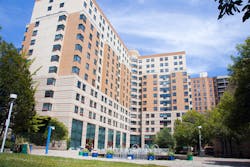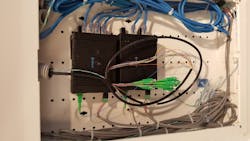Reliability and sustainability at Ryerson University
Located in Toronto’s downtown core, Ryerson University offers more than 100 full-time and part-time undergraduate and graduate programs, innovative learning opportunities and a diverse and welcoming campus community. Home to more than 45,000 students and considered Canada’s leading career-oriented and innovation-led university, Ryerson is making its mark by building for the future and modernizing existing facilities as part of its core development goal of prioritizing the academic, research and employee experience, while remaining focused on the needs of the future. Constructing new spaces and breathing new life into existing spaces cannot be achieved without a keen focus on technology and modernizing the university’s extensive data and voice networks.
Among the exciting projects at Ryerson is Pitman Hall, the university’s largest residence, and the Daphne Cockwell Complex, the newest building on campus with 18 floors of apartment-style residences. While Pitman is a modernization project of an existing facility, and the Daphne Cockwell Complex is new construction, both buildings must provide students with reliable high-speed connectivity and mobility at their homes away from home—and both are doing so using a cost-effective, reliable and sustainable passive optical LAN.
Ideal for both old and new
Pitman Hall is a 14-floor residence with 565 rooms, community kitchenettes, common lounge areas, laundry facilities and study areas on each floor. It also houses a cafeteria, the university’s housing and residence life offices, and a 24-hour study room on the main floor, as well as larger community lounge and a music room on the second floor. Outside of Pitman Hall is the Pitman Quad, a small green space for students to access. Constructed in 1991, Pitman Hall’s original network infrastructure comprised Category 3 twisted-pair copper cabling that was only able to support 10-Mbit/sec transmission speeds with limited wireless coverage. For today’s university students, the campus network is public utility number one, and the network at Pitman Hall did not meet the university’s innovation leadership vision.
While a network upgrade was an absolute necessity at Pitman Hall, Ryerson’s communications infrastructure services team was faced with a significant challenge. The existing cable pathways and conduits throughout Pitman Hall were full, and there was no space to install additional active network equipment in existing telecommunications rooms (TRs) along with the required power and cooling. After exploring their options, Ryerson University realized that a passive optical LAN from Tellabs was the most cost-effective and sustainable option for upgrading the Pitman Hall network and providing the students with high-speed, high-performance access for desktop computers, laptops and smartphones throughout the facility.
Following the success of the Pitman Hall passive optical LAN deployment, Ryerson decided to adopt the same technology for the new Daphne Cockwell Complex residence that opened for the 2019-2020 academic year with apartment-style suites to accommodate 332 students. While the new facility did not pose the same space constraints as an existing facility, the benefits realized at Pitman Hall held true for new construction as well.
“We could have gone with a traditional network approach for the Daphne Cockwell Complex residence, but we had such success with the passive optical LAN at Pitman Hall and the equipment was so reliable, that it just made sense to do it again,” says David Lester, RCDD, Ryerson University’s manager of communication infrastructure services.
A simpler, streamlined and sustainable approach
The Tellabs passive optical LANs selected for Ryerson’s Pitman Hall and Daphne Cockwell Complex residence feature a point-to-multipoint architecture comprising a Tellabs 1150 Optical Line Terminal (OLT) in the main equipment rooms, optical network terminals (ONTs) at the device locations, and a passive singlemode optical fiber infrastructure that uses splitter technology to “split” a single fiber input path into multiple output paths.
Within both residences, Tellabs ONTs terminate to singlemode fiber at device locations and provide standards-based G-PON with Gigabit Ethernet connectivity, including Power over Ethernet (PoE). The ONTs provide four twisted-pair copper outputs to interface with Internet Protocol (IP) enabled devices, including Voice over IP (VoIP) phones, computers, laptops, wireless access points and other devices. This collapses the traditional LAN architecture and converges all IP-based applications onto a single fiber, eliminating disparate networks and minimizing initial capital investment for the renovation.
For Pitman Hall, the 140W ONTs with their small form factor allowed for installation inside walls rather than on or below desktops to eliminate any cabling clutter in the dorm rooms. Due to the nature of the apartment-style suites at the Daphne Cockwell Complex residence, the ONTs were housed in communications enclosures in common areas. Both deployments provided students with the same RJ45 Ethernet wall-outlet connectivity with which they are familiar.
Using Tellabs 24-port 1U rack-mounted 729GP ONTs that deliver Gigabit Ethernet and up to 30 Watts of PoE per port, Ryerson’s passive optical LAN deployments were also leveraged to connect and power wireless access points (WAPs) in common spaces. Ryerson was able to use the system to connect and power outdoor WAPs in the courtyard areas of Pitman Hall and Daphne Cockwell Complex to provide students with the campuswide WiFi they expect.
Because the solution is passive, no power is required from the main equipment room to the work area, eliminating the need for active switches placed in TRs throughout the dormitory that would have been required with a traditional copper-based active Ethernet LAN. Unlike traditional active switches, passive splitters do not require the power, cooling, ventilation and other requirements of a traditional LAN. As a result, the Tellabs passive optical LAN solution reduced the university’s energy costs at the two residence halls by as much as 30 to 65%.
The Tellabs passive optical LAN solution also offers centralized intelligence and real-time management of the network to optimize daily operations. For Ryerson University, all management functions for the entire passive optical network are in one location using Tellabs Panorama PON Manager, a software-defined platform for managing bandwidth, quality of service, authentication, authorization and PoE-enabled devices. Through this one interface, Ryerson IT staff members can configure and reconfigure connectivity much faster and more easily than they could with a traditional LAN. From one console and one screen, the IT staff can perform all moves, adds and changes that arise from day-to-day operations.
“The Tellabs Optical LAN solution allows Ryerson University not only to be sustainable, but it also is cost-effective,” said Ryerson’s Lester. “While network performance for our students is our number-one priority, we are definitely saving a lot on energy consumption, space and maintenance.”
Small footprint conserves physical space
The lightweight, smaller diameter singlemode fiber used to connect the Tellabs passive optical LAN components (i.e., OLT to ONT) uses less cabling material and requires less TR and pathway space, as well as associated pathways materials such as cable tray and penetrations. The solution can serve as many as 8,000 Gigabit Ethernet endpoints, and because the OLT is 90% denser than active Ethernet switches, it requires only 11 rack units with a single equipment rack. Further, a passive optical LAN solution not only needs less physical space, it also has fewer power, fire suppression and HVAC requirements, which helps reduce overhead costs. Rather than being housed in TRs throughout a facility, the passive optical splitters can reside in a central equipment room, further reducing the amount of required space.
The space savings offered by a passive optical LAN solution was especially a benefit at Ryerson’s Pitman Hall with its limited pathway and TR space. Ryerson University was able to reduce pathway, floor, rack and TR space requirements and install multiple fiber risers in an existing HVAC space to deliver unlimited capacity over fiber. Within the Daphne Cockwell Complex residence, the use of a passive optical LAN solution allowed for much smaller TRs and pathways than would have been used within a traditional LAN. The small TRs house one splitter per floor and a few ONTs for connecting hallways WAPs and building automation and electronic safety and security (ESS) devices, as well as 48-volt battery backup power for delivering power to the ONTs in the student suites.
“We did not have the physical room at Pitman Hall to do a traditional network upgrade since we had no space in our telecom closets or in our pathways,” said Lester. “With the passive optical LAN design, we didn’t need to build new telecom rooms and we significantly reduce the size of the conduits. Those were a big plus for the existing residence building as space is at a premium. For the Daphne Cockwell Complex residence, we were able to significantly reduce the pathway and telecom room spaces. This was a key benefit for the architects who fought to save every square inch as usable floor space for student needs.”
Successful, lower-cost deployments
For the renovation of dormitories, maintaining as short of a construction timeline as possible is critical for getting students into their homes away from home in time for classes to start. For Pitman Hall, the deployment of the Tellabs passive optical LAN needed to take place during the 16-week summer break. Since a passive optical LAN deployment is much faster than a traditional LAN deployment, the university was able to accomplish the install of the Tellabs system in less than three weeks.
“The facts that there was less cabling required with smaller conduits, helped speed up the installation and minimized the initial capital investment,” said Lester.
The Tellabs passive optical LANs at Pitman Hall and the Daphne Cockwell Complex residences were fully tested using best practices, including testing the fiber links before going live. For maintenance purposes, the university uses PON Power Meter (PPM-350C) from EXFO. Specifically designed for quick, on-site testing, the PPM-350C enables Ryerson to conduct service activation testing and simultaneously display all passive optical signals, including voice, data and video. Passive optical LANs at both residences are now operational and have surpassed the university’s modernization goals with the following successes.
· Converged network services over fiber-based backbone
· Minimized initial capital investment for the renovation of an existing building
· Conserved physical space with limited pathways and TR space
· Optimized electronics, powering and HVAC for reduced energy and ongoing maintenance savings
· Centralized management of the network to lower daily operation costs, maintenance and time
Despite the reduced energy consumption, space savings and ongoing maintenance and operation costs, the top-line goal for Ryerson University was always to build a high-performance communications network that exceeded student expectations for speed, reliability, capacity and accessibility—both wired and wireless. That has certainly been achieved with the deployment of the Tellabs passive optical LAN at Pitman Hall and the Daphne Cockwell Complex residence. In fact, with universities and colleges around the world moving to online learning and sending most students home due to the global COVID-19 outbreak, Ryerson’s international students who needed to stay on campus were moved into Pitman Hall where they are assured to have reliable internet access and single rooms that allow students to maintain social distancing.
“Our students now have living spaces that provides them with high-speed, high-performance access to digital learning tools, including WiFi and cloud-based networking, via their desktop computers, laptops and smartphones,” said Lester. “This fiber-based network gives the students the connectivity and mobility they need at their homes away from home. And that’s more important than ever right now for our international students who have stayed on campus during the recent global pandemic and need to finish their course work digitally online.”
John Hoover is the director of marketing at Tellabs. John has influenced major industry milestones such as early passive optical networking deployments, telecom video implementations, Voice over IP, and enterprise optical LAN adoption.
Jimmy Gagnon is team leader, business development at EXFO. He has worked in optics and telecommunications for more than 16 years and has been supporting and developing EXFO’s optical test solutions for fiber characterization, specializing in FTTH/POL and CATV networks.
SIDEBAR
Best testing practices to ensure passive optical LAN performance
In a traditional switch-based Ethernet LAN, compliance testing to a variety of performance parameters per industry standards is typically required following installation, and/or to acquire the manufacturer’s system warranty. A passive optical LAN should also be tested to ensure “first-time-right” installation and the ability to meet system transmission requirements. When it comes to testing these systems, there are some best practices to consider.
Connector cleanliness—Every fiber connector in a passive optical LAN should be cleaned and inspected using a visual fiber inspection probe (FIP) or microscope to get a clear assessment of its condition. If a connector fails because of contamination, it is important to clean the connector to avoid reflectance issues and re-inspect.
Optical loss budget—While passive optical LAN splitters are typically trouble-free once installed, it’s important to validate the optical loss budget from end-to-end and measure total link insertion loss (IL) per wavelength. Passive optical LANs use three wavelengths—1490 nm for downstream voice and data, 1310 nm for upstream voice and data, and 1550 nm for downstream for RF video, if applicable. Ideally testing should be done at all three wavelengths but testing at the two most common wavelengths of 1310 and 1550 nm is sufficient to measure link loss and find any potential impairments on the fiber. The maximum IL budget for GPON/XGSPON systems must consider all the elements such as splitters and connector, as well as the fiber attenuation per kilometer, which should range between 13 dB and 28 dB as per the industry PON standards.
Full fiber characterization—To document the full link characterization, an optical time-domain reflectometer (OTDR) is required. In many cases, due to the proximity of optical splitters to one another and other components in the network, it may require more than one measurement to fully characterize the network. OTDRs with advanced algorithms and intelligence can correlate multipulse widths on multiple wavelengths, locate all events and identify faults.
Service activation testing—Once the fiber cables, splitters and connectors have been installed and tested, the ONTs need to be deployed and confirmed ready for service. This is achieved by measuring power levels at the ONT for both downstream (receiver) and upstream (transmitter) using a passthrough PON-specific power meters (PPM) that can provide fast on-site testing and reporting of all signals on the network.
Troubleshooting—Problems such as fiber cuts, inconsistent or lower network performance, connectivity issues, etc. are common situations that can happen once the network is up and running. An optical fiber multimeter (OFM) is ideal for customers to detect transmission issues within a live network, minimizing disruption to users and enabling targeted response to any issues. If more extensive troubleshooting is required, service technicians can use an OTDR to specifically locate events and identify faults.



